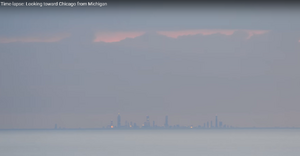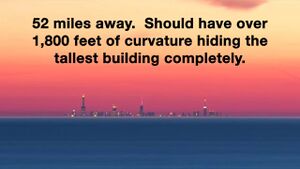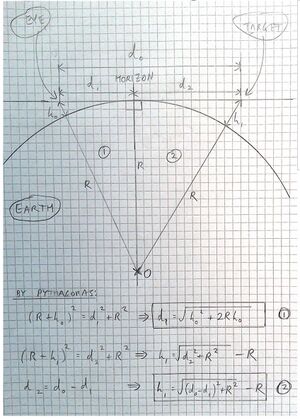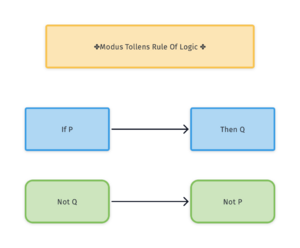Difference between revisions of "Chicago Skyline"
| Line 6: | Line 6: | ||
==Beginner== | ==Beginner== | ||
| − | One of the primary claims regarding the reality that our earth measures flat is that "We see too far." What does this mean? Because we are given a supposed measurement for the radius of the earth, according to the official globe model, we can use math to calculate at what rate objects should disappear in the distance behind this imaginary curvature. The important thing to remember is that this alleged curvature is never actually measured or seen. There are however, countless observations made of distant objects that would be hidden from view if the earth really were a sphere with a radius of 3959 miles. Many observations and photographs of the Chicago Skyline across Lake Michigan are at distances of over 50 miles, an impossibility on a globe of the size claimed. | + | One of the primary claims regarding the reality that our earth measures flat is that "We see too far." What does this mean? Because we are given a supposed measurement for the radius of the earth, according to the official globe model, we can use math to calculate at what rate objects should disappear in the distance behind this imaginary curvature. The important thing to remember is that this alleged curvature is never actually measured or seen. There are however, countless observations made of distant objects that would be hidden from view if the earth really were a sphere with a radius of 3959 miles. Many observations and photographs of the Chicago Skyline across Lake Michigan are at distances of over 50 miles, '''an impossibility on a globe of the size claimed'''. |
==Advanced== | ==Advanced== | ||
Latest revision as of 16:49, 10 February 2022

Contents
Beginner
One of the primary claims regarding the reality that our earth measures flat is that "We see too far." What does this mean? Because we are given a supposed measurement for the radius of the earth, according to the official globe model, we can use math to calculate at what rate objects should disappear in the distance behind this imaginary curvature. The important thing to remember is that this alleged curvature is never actually measured or seen. There are however, countless observations made of distant objects that would be hidden from view if the earth really were a sphere with a radius of 3959 miles. Many observations and photographs of the Chicago Skyline across Lake Michigan are at distances of over 50 miles, an impossibility on a globe of the size claimed.
Advanced
We can use the Pythagorean Theorem to determine the rate at which objects should disappear in the distance if we lived on a globe-shaped object of the dimensions claimed (See diagram at right). The Pythagorean Theorem states that in a right triangle with hypotenuse c and legs a and b, the following equivalency holds: a^2 + b^2 = c^2. Therefore, c = sqrt (a^2 + b^2). This calculation results in a figure of roughly 8 inches per mile squared as the rate of drop due to alleged curvature. Since this is an exponential function, the rate of growth does not remain constant but rather increases rapidly. The tallest building in Chicago, the Willis Tower (formerly the Sears Tower) stands at a height of 1,450 feet, 1,730 feet to the tip of the white antenna. Therefore, if you do the calculations or use a curve calculator, you can verify that most or all of the skyline would be hidden at the distances these photographs have been taken. In addition, Rob Skiba (see video below under the "Refraction" section) has demonstrated that the skyline is in view the entire time one approaches Chicago from Michigan by boat. Claims that this observation is some sort of mirage has been effectively debunked in this and other ways.
Expert
Consider the rule of logic known as Modus_Tollens, also known as denying the consequent. This rule states that If P, then Q. Not Q. Therefore, not P. One can apply this rule of logic to each one of the Chicago Skyline observations. For example: If the earth is a sphere with a radius of 3959 miles (P), then at a distance of 52 miles and an observer height of 6 feet objects will be obscured by the curvature behind 1803 feet of drop (Q) [See curve calculator under References below]. The tallest building in Chicago at a height of 1450 feet can be seen at 52 miles and thus is not dropped 1803 feet behind the curvature (not Q). Therefore the earth cannot be a sphere with a radius of 3959 miles (not P).
Refraction
Claims of Refraction causing the Chicago skyline to loom up over the horizon are not credible. In the video below, Rob Skiba demonstrates that the skyline can be seen continuously as one approaches by boat from Michigan to Chicago. Claims otherwise represent a misunderstanding of how refraction works.
References
“FEI Horizon Calculator.” FEI Horizon Calculator, 2020, https://flatearthinsanity.blogspot.com/p/fei-horizon-calculator.html?
Nowicki, Joshua. “Southwest Michigan - View of Chicago.” Southwest Michigan - View of Chicago, 18 Feb. 2020, https://swmichigan.org/view-of-chicago
“Philosophy Index.” Modus Tollens { Philosophy Index }, 2020, https://www.philosophy-index.com/logic/forms/modus-tollens.php
Roberts, Donna, and Frederick Roberts. “Features Of Exponential Functions.” Exponential Functions - MathBitsNotebook(A1 - CCSS Math), 2020, https://mathbitsnotebook.com/Algebra1/FunctionGraphs/FNGTypeExponential.html
“Willis Tower Fun Facts: Fun Facts for Children.” Skydeck Chicago, 2018, https://theskydeck.com/for-kids/fun-facts/




